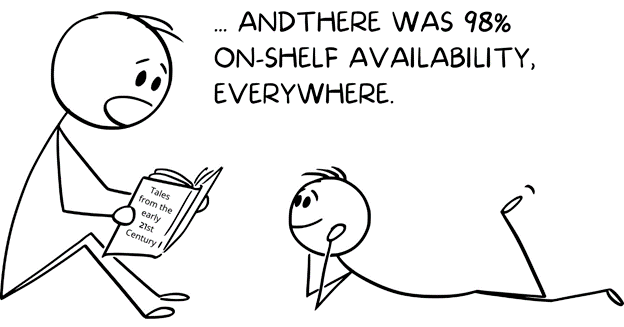You have the foresight to expect your retail customers’ orders are going to take a hit – now what?

Recently I had a conversation with a leading supply chain executive at major CPG company on the effect supply chain disruptions on their business. While not verbatim, what she told me was:
“A disruption in our manufacturing supply chain has delayed new inventory allocations by a month, and my current inventory is not likely to stretch to meet the anticipated inbound orders from two of our largest retail customers. One has a stiff OTIF penalty, but the other was recently a new customer win for Sales. Add into this the uneven flow of orders from a few smaller storefronts. We need a better option for reacting to these new developments—other than just following the ATP plan issued last quarter.”
While CSCOs are busy grappling with broad structural changes needed for more supply chain resiliency, fulfillment teams are often stuck with the challenge of how to manage through the disruption in the here-and-now. CPG brands should likewise investigate new solutions for the better performance at end of the chain, and here’s why.
Supply chain disruptions are costly and likely to continue happening.
From semi-conductors to nitrogen fertilizer, we are all feeling the rippling effect of supply chain disruptions in the form of shortages and rising prices. While the covid pandemic was undoubtedly the primary driver in supply chain disruption over the past two years, most retailers and CPG firms are coming to the realization that the global economic uncertainties causing inventory shortages are likely part of a new normal.
Looking back at 2021, high-profile disruptions included the February freeze in Texas, the lengthy Ever Given blockage in the Suez Canal, the covid-induced Yantian port shutdown in China, a Union Pacific service suspension, and Category 4 Hurricane Ida in New Orleans—just to name a few. Already in 2022, worldwide ripples from the conflict in the Ukraine have only further unsettled our global economy.
CPG firms are now proactively examining the risk categories that can contribute to supply chain shortages, such as too much manufacturing dependency on single locations and supplier or shipping industry consolidations that limit pricing leverage. Yesterday’s “just-in-time” approach to inventory management is shifting to “just-in-case” to adjust for these risks.
But looking for someone else to bear the costs of disruption doesn’t fix the problem.
For retailers, imposing the OTIF penalties and SLAs during supply shortages that were initially created to improve supply reliability during normal operations can result in a reactive increase in prices by the supplier. Often passed on to the final consumer, these sudden price hikes may likely impact consumer demand, hurting everyone. And even with these penalties in place, U.S. retailers still suffered empty shelves costing $82 billion in missed sales last year.
For CPG brands, on the other side, price increases or simplistic first come, first serve responses to supply shortages can rapidly damage valuable retail customer relationships. A survey of retail buyers found that 73% of respondents have ended vendor relationships over delivery issues. In addition, the loss of trust that develops because of supply shortages and irregularities can cause retailers to overstock further and sooner, contributing to what is known as the “bullwhip effect”, where changes in demand at the retail level can progressively cause larger movements in demand that impact wholesalers, distributors, and manufacturers. The result distorts demand forecasts, lengthens the delivery queue—a slippery slope that might not be easy to correct.
Supply chain overhaul can take a long time. What can CPG brands do in the near term?
Use a sophisticated Available to Promise (ATP) solution
ATP and Order Promising systems that normally take 3-4 months to recalibrate can’t help fulfillment managers make immediate decisions about inventory in volatile supply conditions. Without better direction, warehouse managers will resort to first come, first serve, putting major customer relationships in jeopardy as well as increases the risk of OTIF penalties. A superior alternative is Intelligent Order Promising (IOP), the application of sophisticated algorithms of near-term consumption sensing data, guided by pre-determined strategic business objectives and customer segmentation, to produce allocation recommendations across all channels. In turn, this ensures optimized business performance—mitigating sudden gaps between demand and supply. IOP has been shown to improve case fill rate by 4-5% for customers pre-identified as strategic, delivering a 10x ROI from both increased revenues and reduced OTIF penalties.
Share visibility on fulfillment decision strategy
IOP guides the development of pre-determined strategies to address unexpected challenges of supply disruption. Different strategies and their impacts can be shared with employees, customers and investors in a way that develops trust through transparency. It also delivers the power of machine learning to those responsible for final decisions—delivering easy-to-follow guidance, driven by flexible business rules for different business conditions. IOP helps fulfillment see through the noise and confusion of short-term demand volatility and react quickly by automating the prioritization of orders while considering multiple strategic objectives.
Leverage additional data and demand sources
Order history and retail shipments aren’t sufficient to anticipate retail orders. In these volatile times, CPG companies will be caught flat-footed when changes occur. By leveraging additional data sources and demand sources such as weather, events, and consumption data, companies will significantly improve their forecast accuracy. Thus, they can prepare for expected changes and mitigate inventory shortages before they occur.
Intelligent Order Processing is the ideal solution to navigate the new norm of unexpected supply chain disruptions. It’s a real-time extension to Demand Forecasting that introduces risk-based modeling to better calculate allocations base on fill-rate, fill-rate target, and customer priority, as well as an early-warning capability to identify future fill-rate risks. Additionally, IOP produces Optimal Inventory Assignment recommendations upfront, based on hierarchical segmentation, thereby eliminating that outdated, cumbersome and inefficient first come, first serve mindset.

